Chase's Theater and Riggs Building
Introduction
Text-to-speech Audio
In 1911, on this site, a hotel known as The Riggs House was demolished and replaced by a Beaux Arts-style office building, The Riggs Building, completed in 1912 by the distinguished architect Jules Henri de Sibour. The centerpiece of the building was its grand theatrical auditorium, which rose six stories and could accommodate over 1800 audience members. The theater was purchased by B.F. Keith, the "king of vaudeville" in the eastern United States, and legendary performers who appeared there included Will Rogers and Laurel and Hardy.
In 1928, Keith added motion pictures to the presentations at his auditorium and, after sound came in, he switched over to an all-movie format. The theater eventually became the RKO Keith's Theater, and it continued showing movies into the 1970s.
In late 1977, the developer Oliver T. Carr announced plans to demolish the structure, now known as the Keith-Albee Building, as well as a neighboring structure, and build a mall on the square. This led to a long battle between Carr and preservationists who struggled to save the historic buildings. Finally, in 1979, a compromise was reached through which the exterior of the Keith-Albee would be preserved, as long as Carr was allowed to construct an office complex on the square, and so Jules Henri de Sibour's beautiful structure still exists to be admired, but only as a façade for the newer complex.
Images
The Keith-Albee building in 1978, just prior to its demolition
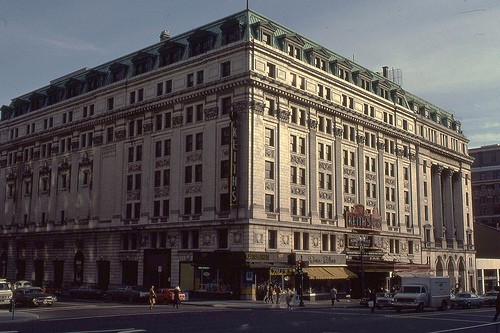
The stage of the B.F. Keith Theater, in the original building
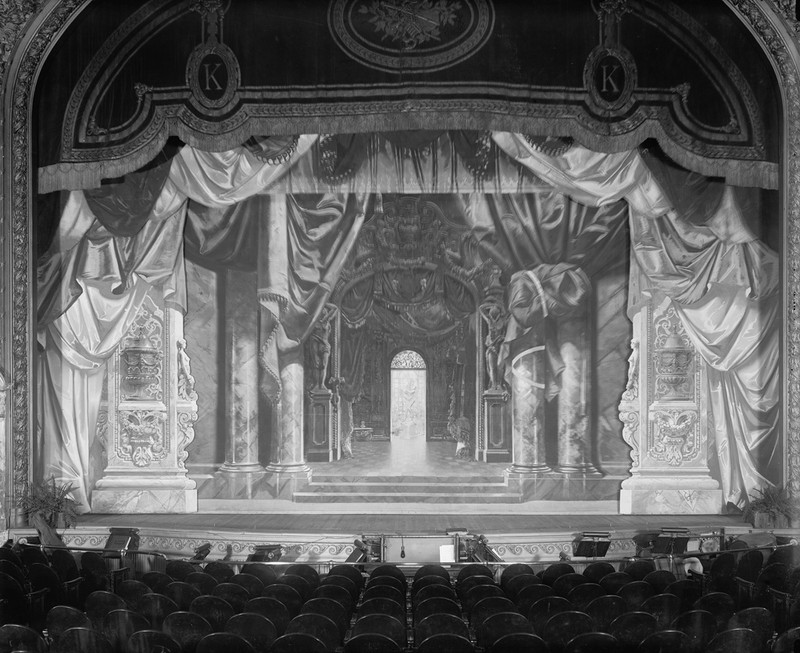
Exterior north façade (detail)
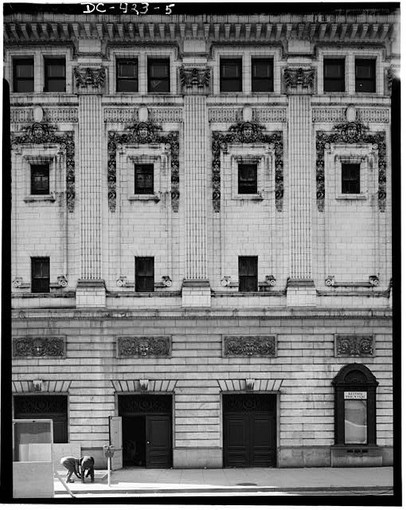
The façade as it appears today
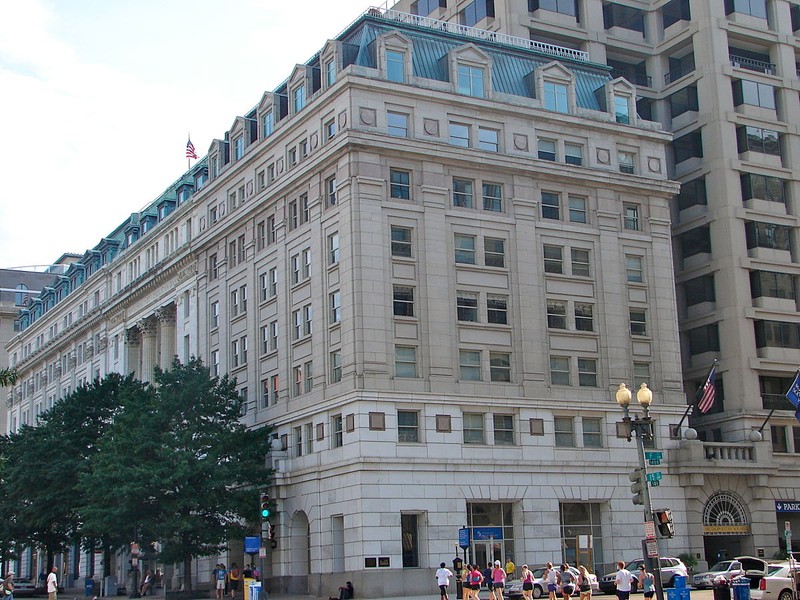
1910s-1920s postcard of the theater
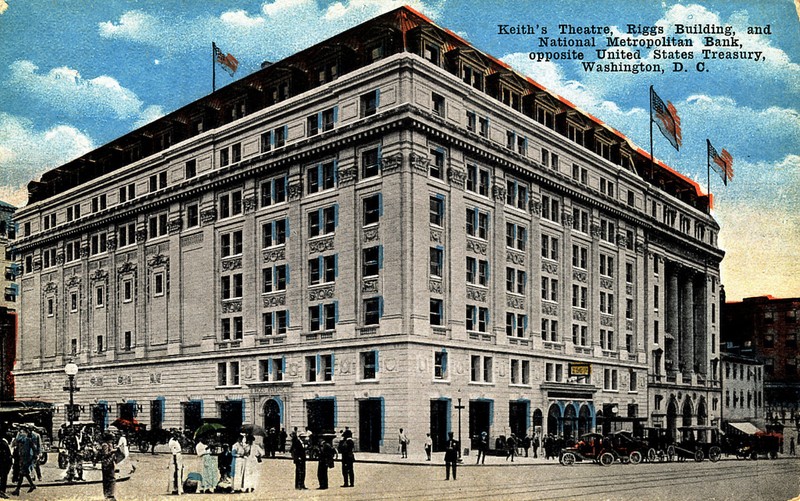
Undated photo of the lobby. Courtesy of the Library of Congress
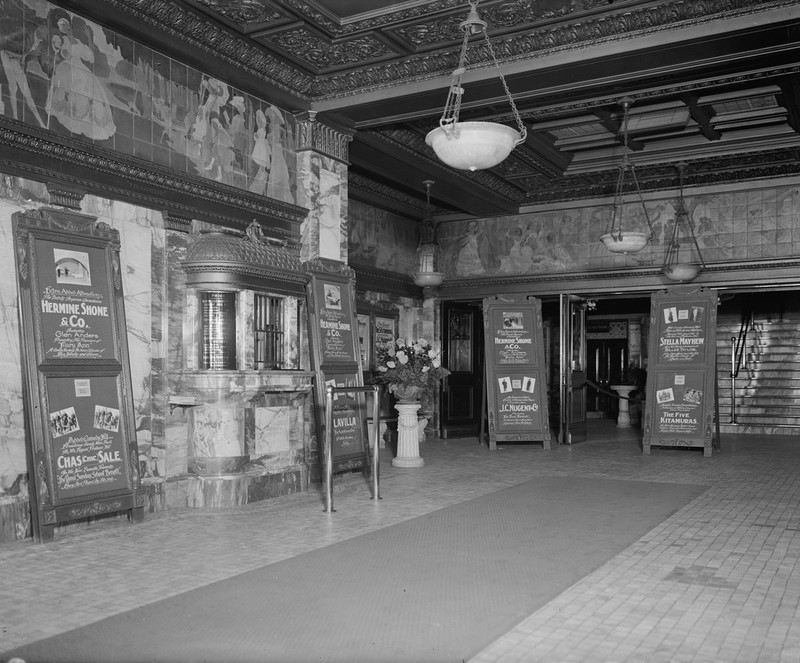
Backstory and Context
Text-to-speech Audio
In 1860, the prominent banker George W. Riggs
built a house in Washington D.C., directly opposite the location where the Treasury
Building now stands; this structure in 1876 became a hotel called the Riggs House. The
descendants of George W. Riggs decided in 1911 to
demolish the hotel and construct an office building in its place. To design the new building, they hired the distinguished French-born architect
Jules Henri de Sibour.
De Sibour, known as The Prince of Beaux Arts, was trained at the Ecole des Beaux Arts in Paris and practiced architecture in Washington for thirty years. (The Beaux Arts architectural style was a monumental neoclassical style popular in the late 19th and early 20th Centuries.) De Sibour maintained the same scale and utilized the same construction materials as the adjoining National Metropolitan Bank Building. The first two floors consist of unpolished white marble and form a base for the Corinthian pilasters extending between the third and sixth floors. The spandrels between the third and fifth floors are decorated with elaborate wreath designs. Above the sixth floor is the building's lower cornice, and the upper cornice contains alternating bands of plain and enriched molding topped by a low recessed parapet. At the top of the building is a copper mansard roof.
The centerpiece of the original building was a huge six-story auditorium that could accommodate 1,838 patrons, in mahogany seats upholstered in red Spanish leather. The walls were covered with tapestry of red silk, and the stage curtain was ruby-red with gold fringes, while the lobby was finished in Siena marble. At first, this theater was leased to Plimpton B. Chase for his “Chase's Polite Vaudeville” (hence the name "Chase's Theater"), but it was almost immediately sold to a famous impresario of the day, B.F. Keith, who ran 30 theaters in the eastern U.S. and had a net worth of about $50 million. Like Chase, Keith was committed to presenting wholesome “family” entertainment, and messages from him were posted backstage warning performers of dire consequences if they used even mild profanity or otherwise offended the audience’s decency. President William Howard Taft was present on opening night at the new Keith Theater, and his successor, Woodrow Wilson, when his health permitted, attended nearly every Saturday evening performance. Stars who appeared at this venue included such legends of the day as comedian Ed Wynn, the family act Eddie Foy and the Little Foys and singers Rudy Vallee and Eddie Cantor.
Vaudeville’s days, however, were numbered. In 1928, Keith introduced motion pictures into his auditorium, and in 1932, after sound came in, he eliminated the live acts altogether, showing only movies from then on. His was the last theater in Washington to abandon vaudeville. After a series of mergers, Keith's theater chain became Radio-Keith-Orpheum (RKO) Radio Pictures Company, which exhibited its premier films at what was now dubbed the RKO Keith's Theatre. (By now the Riggs Building was known as the Keith-Albee Building.) RKO sold the building to Washington developer Morris Cafritz in 1956 for about one-and-a-half million dollars, though it continued to lease the theater to show first-run films. Cafritz tried to arrange a deal with the city of Washington to allow the theater to become a live venue again, but nothing came of this. It continued well into the 1970s to show films, many of which would surely have offended B.F. Keith’s sense of decency.
In 1977, a drama more intense than those shown onscreen began when the developer Oliver Carr acquired the building and expressed his intention to demolish it, as well as the Metropolitan Bank Building on the same square, in order to build a $40 million mall. For two years, preservationists tried to stop Carr; even the First Lady, Roslyn Carter, became involved in the fight to save the buildings on the square. It was a landmark event in the history of the preservation movement in the nation's capital.
When efforts to raise funds to save the structures came to naught, however, Carr began to demolish the rear of the building, which led to public protests and a lawsuit by an organization called Don’t Tear It Down (which later became the D.C. Preservation League). They lost the lawsuit, but Carr offered a last-minute compromise: he would preserve the façades of the Keith-Albee and Metropolitan Bank buildings, in order to construct the Metropolitan Square office complex on the square behind them. He also revealed that he would destroy historic Rhodes Tavern (dating back to 1800), which also stood on the square; supporters of the tavern fought for four more years, but it was finally demolished in 1984, and Carr's office complex built. So, though the actual Keith-Albee building and its magnificent theater are no more, passersby can still admire the magnificent façade designed by Jules Henri de Sibour, the Prince of Beaux Arts.
De Sibour, known as The Prince of Beaux Arts, was trained at the Ecole des Beaux Arts in Paris and practiced architecture in Washington for thirty years. (The Beaux Arts architectural style was a monumental neoclassical style popular in the late 19th and early 20th Centuries.) De Sibour maintained the same scale and utilized the same construction materials as the adjoining National Metropolitan Bank Building. The first two floors consist of unpolished white marble and form a base for the Corinthian pilasters extending between the third and sixth floors. The spandrels between the third and fifth floors are decorated with elaborate wreath designs. Above the sixth floor is the building's lower cornice, and the upper cornice contains alternating bands of plain and enriched molding topped by a low recessed parapet. At the top of the building is a copper mansard roof.
The centerpiece of the original building was a huge six-story auditorium that could accommodate 1,838 patrons, in mahogany seats upholstered in red Spanish leather. The walls were covered with tapestry of red silk, and the stage curtain was ruby-red with gold fringes, while the lobby was finished in Siena marble. At first, this theater was leased to Plimpton B. Chase for his “Chase's Polite Vaudeville” (hence the name "Chase's Theater"), but it was almost immediately sold to a famous impresario of the day, B.F. Keith, who ran 30 theaters in the eastern U.S. and had a net worth of about $50 million. Like Chase, Keith was committed to presenting wholesome “family” entertainment, and messages from him were posted backstage warning performers of dire consequences if they used even mild profanity or otherwise offended the audience’s decency. President William Howard Taft was present on opening night at the new Keith Theater, and his successor, Woodrow Wilson, when his health permitted, attended nearly every Saturday evening performance. Stars who appeared at this venue included such legends of the day as comedian Ed Wynn, the family act Eddie Foy and the Little Foys and singers Rudy Vallee and Eddie Cantor.
Vaudeville’s days, however, were numbered. In 1928, Keith introduced motion pictures into his auditorium, and in 1932, after sound came in, he eliminated the live acts altogether, showing only movies from then on. His was the last theater in Washington to abandon vaudeville. After a series of mergers, Keith's theater chain became Radio-Keith-Orpheum (RKO) Radio Pictures Company, which exhibited its premier films at what was now dubbed the RKO Keith's Theatre. (By now the Riggs Building was known as the Keith-Albee Building.) RKO sold the building to Washington developer Morris Cafritz in 1956 for about one-and-a-half million dollars, though it continued to lease the theater to show first-run films. Cafritz tried to arrange a deal with the city of Washington to allow the theater to become a live venue again, but nothing came of this. It continued well into the 1970s to show films, many of which would surely have offended B.F. Keith’s sense of decency.
In 1977, a drama more intense than those shown onscreen began when the developer Oliver Carr acquired the building and expressed his intention to demolish it, as well as the Metropolitan Bank Building on the same square, in order to build a $40 million mall. For two years, preservationists tried to stop Carr; even the First Lady, Roslyn Carter, became involved in the fight to save the buildings on the square. It was a landmark event in the history of the preservation movement in the nation's capital.
When efforts to raise funds to save the structures came to naught, however, Carr began to demolish the rear of the building, which led to public protests and a lawsuit by an organization called Don’t Tear It Down (which later became the D.C. Preservation League). They lost the lawsuit, but Carr offered a last-minute compromise: he would preserve the façades of the Keith-Albee and Metropolitan Bank buildings, in order to construct the Metropolitan Square office complex on the square behind them. He also revealed that he would destroy historic Rhodes Tavern (dating back to 1800), which also stood on the square; supporters of the tavern fought for four more years, but it was finally demolished in 1984, and Carr's office complex built. So, though the actual Keith-Albee building and its magnificent theater are no more, passersby can still admire the magnificent façade designed by Jules Henri de Sibour, the Prince of Beaux Arts.
Cite This Entry
Baldwin, John and Mike Emett . "Chase's Theater and Riggs Building." Clio: Your Guide to History. October 5, 2016. Accessed January 20, 2025. https://theclio.com/entry/21209
Sources
http://focus.nps.gov/pdfhost/docs/NRHP/Text/78003053.pdf
http://www.streetsofwashington.com/2010/05/vaudeville-and-other-high-drama-at-15th.html
http://www.streetsofwashington.com/2009/11/and-one-block-north.html
bit.ly/1IXJhao
http://www.washingtonlife.com/2007/10/01/the-prince-of-beaux-arts
http://architecture.about.com/od/periodsstyles/g/Beaux-Arts-Architecture.htm


